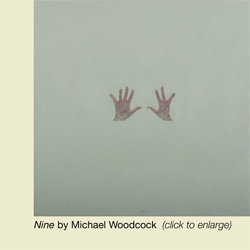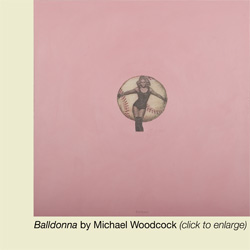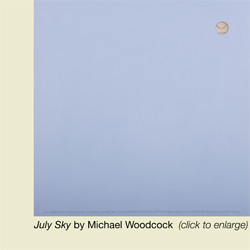| |
Heaven and Earth: Thoughts on Baseball, Art, and Other Altered States
The
war drags on, markets crash, the artic melts, world leaders
rise and fall, yet there remains a constant: another glorious
beginning to
a season of baseball. To commemorate this sublime pastime in the year, 2332 — a
contemporary group art exhibition demonstrating the correlation
between art and baseball — exhibited at the Huntington
Beach Art Center in the fall of 2008. On display were works by Stuart
Allen Travis
Collinson, Dean
De
Cocker, Matthew Furmanski, Jimi
Gleason, Robert Jacka, Ian M. Kennelly, Juan
Thorp and Michael
Woodcock. The multimedia
exhibition was accompanied by a catalogue (PDF
here) with original
essays contributed by Albert
Wachtel, Richard
Chang and the following
by Nathan Callahan:
HEAVEN
AND EARTH
Thoughts on Baseball, Art and Other Altered States
MYSTERY
The nameless is the beginning of art and baseball. While the named
is the mother of statistics, the nameless is the gateway to the
mystery of everlasting hardball truth.
After
an impossibly difficult catch in a field position he rarely plays,
the Dodger’s Nomar
Garciaparra said, "That's baseball.
You can't explain it. You can't figure it out. You find somebody
who does and I'll call him a liar."
After
several bad canvasses, artist Edgar
Degas said, "Only when
he no longer knows what he is doing does the painter do good things."
 I
asked 2332 artist Travis
Collinson for some coaching
about the mysterious spirit of the game. He suggested I see “Bull
Durham.” At
one point in this baseball movie classic, Susan Sarandon’s
character, Annie Savoy, philosophizes. “I believe in the
Church of Baseball. I've tried all the major religions,
and most of the minor ones. I've worshipped Buddha, Allah, Brahma,
Vishnu,
Shiva,
trees,
mushrooms, and Isadora Duncan. I know things. For instance,
there are 108 beads in a Catholic rosary and there are 108 stitches
in a baseball. When I learned that, I gave Jesus a chance. But
it just
didn't work out between us. The Lord laid too much guilt on
me.
I prefer metaphysics to theology.” I
asked 2332 artist Travis
Collinson for some coaching
about the mysterious spirit of the game. He suggested I see “Bull
Durham.” At
one point in this baseball movie classic, Susan Sarandon’s
character, Annie Savoy, philosophizes. “I believe in the
Church of Baseball. I've tried all the major religions,
and most of the minor ones. I've worshipped Buddha, Allah, Brahma,
Vishnu,
Shiva,
trees,
mushrooms, and Isadora Duncan. I know things. For instance,
there are 108 beads in a Catholic rosary and there are 108 stitches
in a baseball. When I learned that, I gave Jesus a chance. But
it just
didn't work out between us. The Lord laid too much guilt on
me.
I prefer metaphysics to theology.”
Although
clear about the metaphysics, Annie was mistaken about the statistics.
There
are 59 beads in a Catholic rosary, not
108. Sister
Peggy of the Orange County Diocese confirmed it. She even
counted her own rosary with me. “59 beads,” she said. “That’s
all.” For Annie’s sake (and for Collinson’s,
too), Sister Peggy and I tried to reach the number 108 (subtract
three Lord’s
prayers and a Gloria—multiply by two), but Annie Savoy’s
108-bead rosary was nowhere to be found in the catechism.
That’s
the problem with statistics. They rarely embody the truth
of the game or the canvas.
There
is, however, mystery remaining in a baseball’s 108 stitches.
108
suitors coveted Penelope, the wife of Odysseus, in Homer's Odyssey.
108
sacred stars shine in Chinese astrology and Tao philosophy.
108
minutes is the duration of the first manned space flight.
108
holy temples enshrine Vishnu.
108
is the name of the Italian artist who paints huge otherworldly
figures in public spaces.
108
Joya-no-kane chimes ring in Japan’s
New Year.
108
human sins are avoided in Buddhist belief.
108
poses are danced by Shiva.
108
is one to the first times two to the second times three to the
third. One,
two, three strikes, you’re out.
It
could have been the mysterious precision of circumstance or even
a revealing
of the unnamed. In any case,
on the 108th game
of the
1963 season, Dodger outfielder Frank
Howard walked.
A basketball and baseball All-American
at Ohio State, Howard
was initially
drafted by the Philadelphia Warriors
of the National Basketball Association.
At a mondo six foot eight inches 275
pounds, he chose baseball and the Dodgers instead—his
teammates dubbing him “Hondo” after
John Wayne’s mythological big-ass
cowboy character from the movie of
the same name. Hondo was big, but
he was
slow. Earlier in
1963, Howard was the designated Dodger
Stadium photo-op prop at Nun’s
Day, where he slowly scrawled autographs
and grinned as the Nuns looked skyward
in amazement at his hebetudinous immensity.
You can bet they
had their 59 beads with them.
Be
that as it may, in the 108th game of the
season, Howard, the biggest
and tallest
man
in baseball,
worked a walk
on a 3 and
2 pitch and
hovered over first base, standing
tall and wide against the baseball
canvas.
No one
could have
expected what
happened next.
“Bennett
looks in for his sign. The windup.”
Suddenly
Howard broke with the pitch. The stadium was silent. Even Vin
Scully was at
a loss. No one
had ever witnessed a man so big trying to go so fast. The cadence of his
stride was hypnotically
slow.
Time
became eternity in the universe
of
Chavez Ravine. When Hondo kicked feet first into the air and slid, all
42,108 in attendance audibly
gasped. As the umpire spread
his arms to signal safe, a
human sound of awe-inspired joy reverberated from
the stands
and
swept across
the field. Frank Howard had
stolen second. Let the mind rest
at peace.
“It's a long season and you gotta trust,” Annie Savoy said still
trying to convey the mystery. “I've
tried 'em all, I really have,
and the only church that truly
feeds the soul, day in, day
out,
is the Church of Baseball.”
RITUAL
Like the Hindu sadhus, the
holy men dedicated to achieving
liberation
through rituals
of meditation and contemplation
of God, I believe
that heaven is more dangerous
for a living soul than hell,
as its
highs
are more
illusory. A
heavenly inspiration
can be misplayed
into the error of overconfidence,
or
worse yet invulnerability.
While it
may make its appearance
as a fifth inning grand slam,
heaven
can
exit in the ninth
as the limp
tail of a
losing rally
monkey. Heaven
is
not ours to own, but rather
a frozen point of divine
visitation: a hallucination, a dream.
In baseball
and art, an altered state
of consciousness is the
pathway for arriving at
that
point. The danger is in
the illusion. Even so,
unless art
or baseball
moves its
audience
into
an altered
state, it hasn’t been
successful. Without rituals,
we would have neither access
nor escape from that state.
 Disciples
of baseball rejoice
in many rituals — batting
stance dances, rally cap
origami, pitching delivery
poses, rosin
bag bounces,
strikes of the umpire’s
brush, deciphering batting
average numerology — to
find a path to heaven. Disciples
of baseball rejoice
in many rituals — batting
stance dances, rally cap
origami, pitching delivery
poses, rosin
bag bounces,
strikes of the umpire’s
brush, deciphering batting
average numerology — to
find a path to heaven.
“Baseball
still has more ritual than the Methodist church,” 2332 artist Robert Jacka told
me, “as evidenced by the team that shares
women's thong bikinis.”
And
so it came to pass that
the Angels’ wives
gave me the stink eye—their
monkeys limp, their
team losing, and my
team for
the night, the Oakland
Athletics, clubbing
the Angels big time
at the
Big A. As a minor league
political payback, Anaheim
Mayor Tom Daley
had gifted his club
level suite to my friend
Tim
Carpenter, who at the
time was a partisan
batboy for Jerry “Moonbeam” Brown,
the newly elected Mayor
of Oakland. Tim and
I, along with some friends
from "The Tell" mural
project in Laguna Canyon,
were sitting in the
stadium’s
most expensive, if not
elite, seating. We were
not there as Angel fans,
but rather to sing the
praises of Moonbeam’s
team, the Oakland A’s,
whose holy charisma
had been established
two decades
earlier by the most
artfully-named pitching
staff in baseball,
ever — Catfish
Hunter, Vida Blue, Rollie
Fingers,
and Blue Moon Odom.
Amen.
By an act of Autry,
the Angel’s wives
sat in the suite next
to us. Out of respect,
we tried to stifle our
more colorful pro-Oakland
ritualistic cheers.
But when the A’s
Jason Giambi rocketed
a Tim Belcher sixth-inning
slider into the “Outfield
Extravaganza” (the
California coastline
tidepool simulacra bubbling
on a fiberglass rockpile
that serves as the stadium’s
bogus signature piece
and center field homerun
depository), we erupted.
Pounding the balustrade,
speaking
in tongues, and howling
to the heavens, we chanted
in faux Hindu reverence "Mekka-lekka
hi mekka hiney ho",
bowing like a mini-wave. “Long
live Giambi.”
Hence,
the stare.
Giambi,
for the record, later admitted to
a federal grand
jury that he
took steroids and
human growth
hormone. That
home run
we watched
was juiced. Like
Basquiat on junk or Pollock
on bourbon, Giambi
was in an
altered state.
To his
credit, he
was wearing his
lucky codpiece
to break out of
a batting
slump — a
gold lamé woman’s
thong with a flame-line
waistband. Giambi
continues this baseball
ritual to this day,
even going so far
as to share the
undergarment with
teammates when
they are in need.
By
the middle of
the seventh inning
at
Anaheim, the
A’s were
leading 5-1. Yet,
when “Take
Me Out to the Ballgame” played,
our group and the
Angels’ wives
(Mrs. Belcher included)
stood together,
singing, smiling,
rocking and exchanging
knowing glances.
That ritual transformed
us into a congregation,
not a club. Hallelujah.
As 2332 artist
Robert Jacka told
me, “At
a game, you can
observe small
vignettes of people
performing,
or bits of historical
information
about little-known
or unknown moments,
then you will
join together
and sing.
If that is not
church than I
don't what
is.”
It
is the closest we
can get to
heaven.
The
Angels won 7-5.
TRANSCENDENCE
Somewhere between
mystery
and ritual lies
transcendence:
the
place that
exists untethered
to the material
universe
and the confines
of time.
Art, like baseball,
gives us
a window to this altered
state.
 “In
your life, you work and you wait and you work and you wait,” 2332 artist
Michael Woodcock tells me, “and then something connects.
The art-making
is what gets the artist to that connection — when
something
happens that’s so magical you say ‘Alllll right,
there’s
hope.’” “In
your life, you work and you wait and you work and you wait,” 2332 artist
Michael Woodcock tells me, “and then something connects.
The art-making
is what gets the artist to that connection — when
something
happens that’s so magical you say ‘Alllll right,
there’s
hope.’”
Like
an artistic
revelation,
baseball's
action
hinges
on that
connecting
instant — an
exchange
from
defense
to offense
where
only
instinct
survives.
It
takes less
than
one-quarter
of
a second
for
a
rising fastball
to
cross
home
plate.
On
June 12,
1970,
a
sculptor
of
that
slice
of
time, Dock
Ellis of
the Pittsburgh
Pirates,
pitched
a
no-hitter under
the
influence
of
Lysergic acid
diethylamide.
"I
was in Los Angeles, and the team was playing in San Diego, but
I didn't
know it. I had taken LSD,” Ellis said. “I thought
it was an off-day, that's how come I had it in me.”
In
a psychedelically
ecstatic trance,
Ellis flew
to San
Diego for
his twilight
start.
“I
was zeroed in on the glove, “Ellis said, his concentration
in the game sublimely focused on the trails of the ball and
the tunnel to the
plate where the foul lines became a vanishing point at the
center of a 90-degree perspective.
Ellis’ heightened
state highlights what 2332 artist Stuart
Allen calls, “the
mind-body disconnect.” Currently training
for a marathon, Allen says, “When I stopped thinking
about running while running, things changed. It's a matter
of the body performing
the function without the conscious mind. It becomes a form
of meditation. In baseball, this disconnect is critical because,
like other reaction-based
sports, there is no time to consciously process the events.
Your body has to just ‘know’ what to do, without
you telling it.”
Artists,
like ballplayers,
develop their
senses to
unconsciously transcend
the moment — zeroing in beyond body and mind to a
territory transcending the confines of personal involvement.
The audience is
invited to experience this territory in an immediate, simple,
and direct fashion with a gasp, an awe, or a cheer that
connects to a
unified consciousness released from the tyranny of the
day-to-day. It is a consciousness that travels beyond the
confines of the gallery
or the stadium.
“As
a child, even though TV was everywhere, my dad still listened
to
the world series on the radio,” 2332 artist Matthew Furmanski
tells me. “Although it would have been easy to flip on the tube,
and watch the game, we listened to it,” he continues. “We
used our imaginations to ‘watch’ the game.”
Imagine.
“Two
outs. Ninth inning. Ed Spiezio is batting for Ron Herbel. Ellis
working on the veteran Spiezio. The game, right now, is at the
plate. Dock looks
in. Into his windup. The pitch. Spiezio swings. It’s
a high fly ball deep to left center. Alou back to the warning track. He leaps.
I don’t believe what I just saw.”
There,
from the
players’ perspective, in that artistic state
of transcendence, it’s the ball and the heavens and the possibilities.
— Nathan
Callahan, September 27, 2008
|
|